We woke up at 7 a.m. and wished one another a happy Easter. The girls who were supposed to share our room had luckily slept in the lounge, so it had been an uneventful night. I guess my feet hung over the edge of the bed and I would occasionally kick the beer bottles during the night, so Craig and Stan had dreams about bars. Stan realized what the noise was and moved the bottles out of my reach.
Craig asked, "Did the Easter Bunny come?" Stan rummaged around in his bag and said, "The Easter bunny came!" producing a Cadbury Mad About Chocolate truffle egg for each of us. Hooray! We packed up and then went into the kitchen, using the microwave to heat up our Easter hot cross buns. There were brochures, books, magazines, games and puzzles available at the backpackers. It was very nice. On my way to the bathroom I took pictures of some of their sheep.
We hit the road shortly before 8:30. Our first stop was Slope Point, the southernmost point of NZ's South Island. We parked the van and walked across some sheep farmland to get to the point. It was windy and chilly. We reached the lighthouse that marked the spot, on a cliff overlooking the ocean. This is very rugged country: a land of extremes. A sign gave the distance that Slope Point is from the South Pole and the equator (the former is 4803 km, and the latter is 5140 km). Nearly equidistant.
We then stopped at the fossilized forest at Curio Bay. It is a very interesting area where the waves break over a layer of petrified forest. Large waves were flowing down a rock channel making long rubbery strands of kelp float and swirl in abstract designs. There were many small snails within the cracks of the rocks. Sometimes penguins are seen in this area, but this was the moulting season for them.
We stopped at the Curio Bay campground to have a wander to see if we could see any dolphins. The campground was really nice; each campsite was nestled into small groves of flax, which gave it a lot of privacy and a sort of Dr. Seuss-looking landscape. We didn't see any dolphins, but we enjoyed the walk. We then drove to Tautuku. We took a twenty-minute walk through the forest while Stan taught us about the vegetation and wildlife of the area. The forest was very lush, and we could hear bellbirds and tui very clearly.
Stan studied the New Zealand rimu tree for his thesis, and has done plant survey work for DOC. He told us the Maori legend of Rata. Rata cut down a tree to make a canoe; but the next morning the tree was standing again. He cut it down for a second time, and the following day it was standing. The birds of the forest had repaired the tree overnight. Rata had not asked the gods for permission to use the tree. When he apologized and asked permission, the gods instructed the birds to help him to build the canoe.
Toward the end of the walk, we entered a section of dunes and could hear the ocean's roar. We popped out of the forest on a beautiful and secluded beach. Stan retraced our steps through the woods back to the van, allowing us to have a private walk down the beach. Ours were the only footprints that we could see. The tide was out and there were striations in the sand from high tides past. There were lots of dead brine shrimp on the sand. The waves were gorgeous.
Stan picked us up at the road on the far end of the beach, and we hopped into the van. We drove for a few minutes and then parked on the side of the road to collect firewood in a small gully for tonight's hangi feast. We would need lots of small sticks for the pit in the ground, and some larger logs for the campfire.
Once we had collected enough wood, we drove to Cannibal Bay. We set up camp on farmland owned by an old man who, to us, sounded like Buzz Fledderjohn, a character in a Tom Waits song. There are several "baches" (short for "bachelors", a kiwi word for small cabins) on the property and an old woolshed in disrepair. Stan had never seen anyone in the baches before, but this being Easter weekend they were all full. As the owner of the place wasn't around, I had to insert $4 worth of coins into a slot cut in the clapboard of one of the baches as a camping fee.
Stan has said that we could sleep inside the old woolshed, but it was just too creepy. There were a bunch of floorboards missing and it just reminded me too much of the "Blair Witch Project". We decided to stick with the tents, thanks. We set up two small tents and ate a lunch of sandwiches, tea, and Tim Tam biscuits. Stan extolled the virtues of Toffee Pops and Chit Chats as well, though we hadn't bought any of those.
Then Stan dug a hole in the ground and started a fire inside the hole for the hangi feast, a Maori tradition. The idea is to create a small but hot fire which will heat up five flat rocks. Once the rocks have heated sufficiently, you put the food on them, and bury them, letting it all cook from the heat and steam of the rocks. Craig dressed the lamb shank with lots of garlic and wrapped it in tin foil. We wrapped the potatoes and "pumpkin" (a light green squash) in foil as well. Stan placed the lamb shank on the hottest rock. We then piled up the kumara, unshucked corn on the cob, pumpkin, potatoes, and onions. Stan covered the food with wet tea towels and then shoveled dirt onto the top. He poured some hot water around the edges of the pile to keep it moist.
We took a walk down to Cannibal Bay Beach to look for sea lions. There was one on the far end of the beach, but it fled up into the dunes when some people approached it. By the time we finished our walk, we were the only ones on the beach. I walked barefoot on the fine sand. It was a bit chilly, but it wasn't too bad.
We walked back to camp. Some kids from the baches asked if we had anything we wanted to trade for four paua (abalone-type shell fish). We declined, as we had all of the hangi food cooking. A chicken wandered over to the hangi pile. The kids in the baches had a dog with them, and we had visions of returning to camp to find that the dog had dug up our lamb shank.
Then Stan drove us to a nearby farm. Hiking NZ has an arrangement with the owners of the farmland to use their blind to view yellow-eyed penguins. The penguins come onto shore around sunset each night, and walk/hop to their nests (they can go as far as 1 km inland!) The yellow-eyed penguin is the world's third largest penguin (after the king and the emperor). There are only about 5000 yellow-eyed penguins in existence. 30 of them live off of Cannibal Bay. We were eager to see penguins in their native habitat (they only exist in the Southern hemisphere in the wild, and we had only ever seen them in aquariums or zoos), but we didn't want to get our hopes up too much lest we be disappointed if none were to show up. Our luck so far that day with the dolphins and sea lions was disheartening.
We parked the van and walked through lush and verdant farmland to the coast. We sat in a blind on a cliff edge overlooking the beach below. We immediately saw one penguin in the grass. We were relieved and excited to have at least seen one. We watched the sea, and suddenly saw a penguin come riding a wave to shore on its belly. It waddled up the beach until it reached a hill, and then it began hopping up the hill until it reached the top which was covered with trees and lush grass. It seemed weird enough to see a penguin in the wild in the ocean, let alone on farmland! It was surreal. Stan said it gets even more surreal when the sheep are in that pasture with them. We quietly remained crouched down and the penguins kept coming ashore at steady intervals. With each new arrival we became more and more excited. Sometimes we spotted them in the sea. Other times we didn't realize we were there until we could hear the pitter-patter of their webbed feet on the sand below us. They seemed to congregate in pairs, and they were communicating with one another.
Before we knew it the count was up to 8. Stan's record was 9 penguins in one viewing, so we decided to stick around and try to tie his record. Aha! 9! 10. Then 11, 12, and 13!! A new record! We watched them until the sun set, at which point we headed back to the van, very hyper after seeing 13 penguins. The stars were amazing, and once again we admired Orion, the Southern Cross, and the Milky Way.
We drove back to camp. Stan decided that we should try the paua after all; that we could eat it in addition to the hangi and eat any leftovers tomorrow. He went to the baches in search of the kids. He returned with a plastic container full to the brim of nicely minced paua for which he had paid a few dollars. He cooked it up in olive oil and garlic while we started a campfire.
Stan was a bit worried about the hangi, as the rocks hadn't gotten as hot as he had hoped because the firewood was too wet. He dug up the hangi to find that the veges were fine, but the lamb wasn't completely done. There was certainly enough cooked lamb to feed us that night, though. The meal was a mixture of cultures: a Maori hangi feast on Easter. Craig loved the paua. I found it very tasty but a bit rubbery (I'm pretty picky when it comes to seafood).
After dinner we sat around the campfire. The old man who owns the place (very long white beard and a limp) drove up in his big old boat-like car by our site and over to the baches. Stan announced that the Easter Bunny had come again, and he produced three more Cadbury Mad About Chocolate truffle eggs. We hung out by the fire, talking about all sorts of things. We learned that Stan is a big fan of Tom Waits, which led to lots of interesting conversation. I wrote in the journal by the fire. As the night grew later, the sheep started acting up and becoming very noisy. We went to bed at 11:30.
|
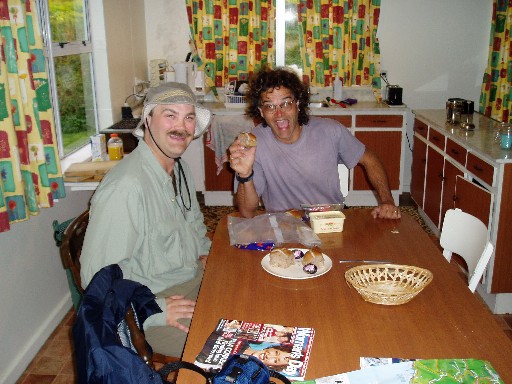
Easter breakfast: hot cross buns and chocolate eggs
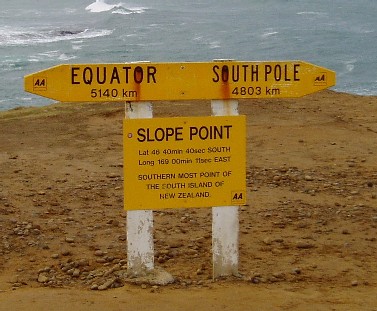
Slope Point, the southernmost point of NZ's South Island
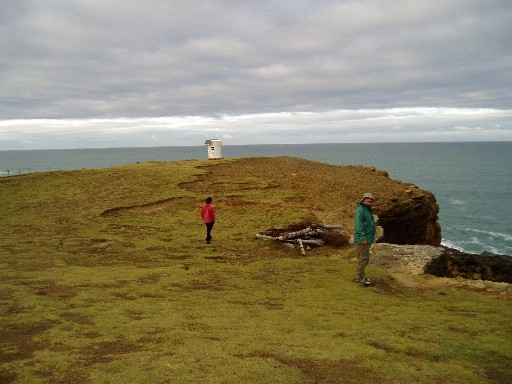
Slope Point, the southernmost point of NZ's South Island
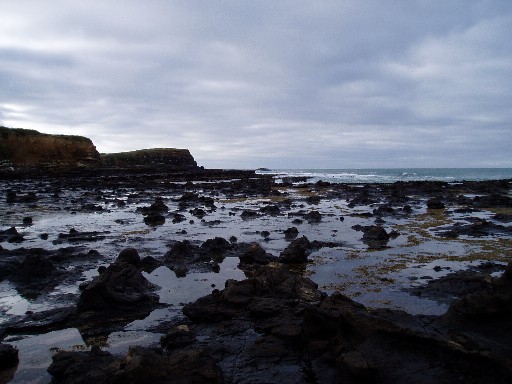
Petrified Forest
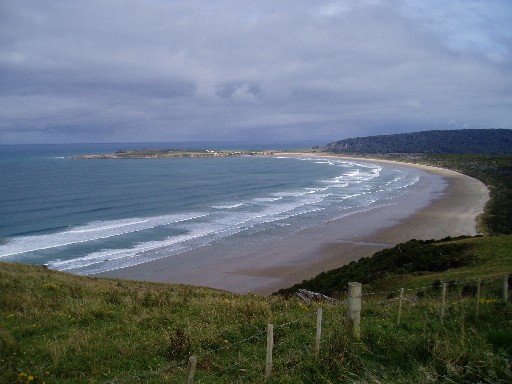
Beach in the Catlins
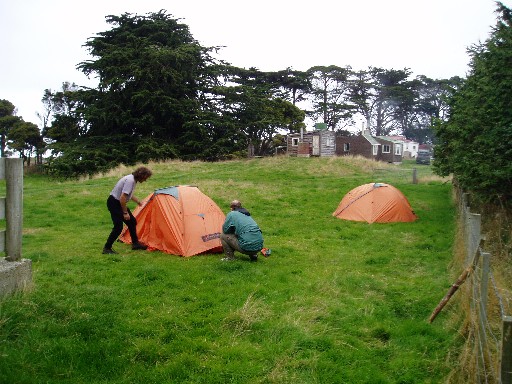
Stan and Craig putting up the tent
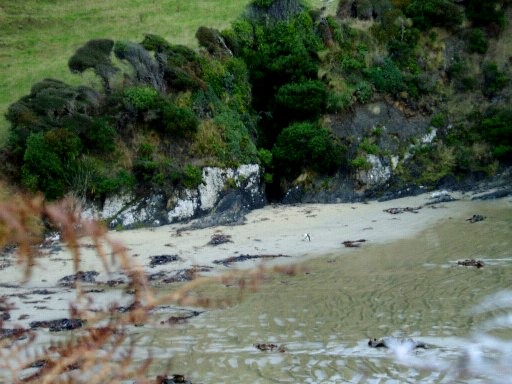
Penguin coming ashore for the night
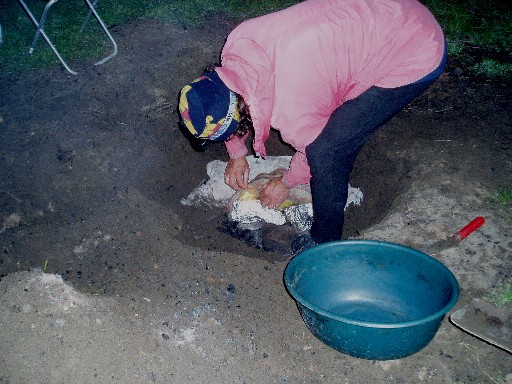
Stan digging up the hangi

|






